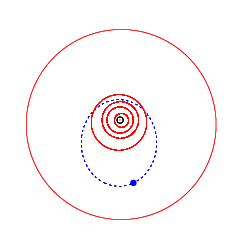 Animated orbit of 9950 ESA | |
| Discovery [1] | |
|---|---|
| Discovered by | C. Pollas |
| Discovery site | Caussols Obs. (010) |
| Discovery date | 8 November 1990 |
| Designations | |
| (9950) ESA | |
Named after | European Space Agency [2] |
| 1990 VB | |
| NEO · Amor [1][3][4] Mars-crosser | |
| Orbital characteristics [1] | |
| Epoch 4 September 2017 (JD 2458000.5) | |
| Uncertainty parameter 0 | |
| Observation arc | 26.90 yr (9,824 days) |
| Aphelion | 3.7367 AU |
| Perihelion | 1.1391 AU |
| 2.4379 AU | |
| Eccentricity | 0.5328 |
| 3.81 yr (1,390 days) | |
| 17.795° | |
| 0° 15m 32.04s / day | |
| Inclination | 14.597° |
| 253.51° | |
| 103.57° | |
| Earth MOID | 0.2806 AU · 109.3 LD |
| Physical characteristics | |
| Dimensions | 1.71 km (calculated)[5] 3 km (estimated)[4]: 21 |
| 6.707±0.002 h[6][a] 6.7078±0.0007 h[7] 6.712±0.005 h[8][b] | |
| 0.20 (assumed)[5] | |
| S (assumed)[5] | |
| 16.2[1][5] | |
9950 ESA, provisional designation 1990 VB, is an eccentric asteroid and elongated near-Earth object of the Amor group, approximately 1.7 kilometers in diameter. It was discovered on 8 November 1990, by French astronomer Christian Pollas at the Centre de recherches en géodynamique et astrométrie (Cerga) at Caussols in southeastern France.[3] It was named for the European Space Agency (ESA).[2]
- ^ a b c d Cite error: The named reference
jpldatawas invoked but never defined (see the help page). - ^ a b Cite error: The named reference
springerwas invoked but never defined (see the help page). - ^ a b Cite error: The named reference
MPC-objectwas invoked but never defined (see the help page). - ^ a b Cite error: The named reference
Harris-1991was invoked but never defined (see the help page). - ^ a b c d Cite error: The named reference
lcdbwas invoked but never defined (see the help page). - ^ Cite error: The named reference
Stephens-2014dwas invoked but never defined (see the help page). - ^ Cite error: The named reference
Vaduvescu-2017was invoked but never defined (see the help page). - ^ Cite error: The named reference
Warner-2014bwas invoked but never defined (see the help page).
Cite error: There are <ref group=lower-alpha> tags or {{efn}} templates on this page, but the references will not show without a {{reflist|group=lower-alpha}} template or {{notelist}} template (see the help page).